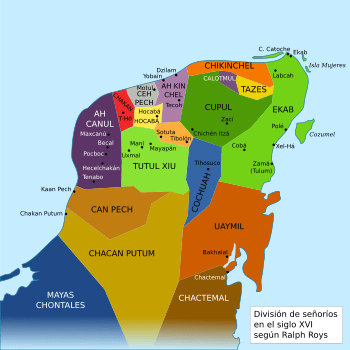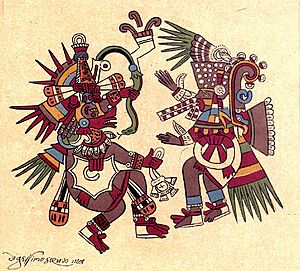Hocabá-Homún facts for kids
Quick facts for kids
Kuchkabal Hocabá-Homún
|
|||||||||
|---|---|---|---|---|---|---|---|---|---|
| 1443–1547 | |||||||||

Kuchkabals of Yucatan after 1461.
|
|||||||||
| Capital | Hocabá | ||||||||
| Common languages | Official language: Yucatec |
||||||||
| Religion | Maya religion | ||||||||
| Government | Monarchy | ||||||||
| Halach Uinik | |||||||||
| Historical era | Post Classic Period / Early Modern | ||||||||
|
• Established
|
1443 | ||||||||
|
• Disestablished
|
1547 | ||||||||
|
|||||||||
Hocabá-Homún, also known as Hokabá-Homún or just Hocabá, was a powerful Maya state. It was located in the northwestern part of the Yucatán Peninsula. This state existed before the Spanish explorers arrived in the 1500s. It was one of the many independent states that formed after the fall of a larger Maya alliance.
Contents
What Does Hocabá-Homún Mean?
The name Hocabá-Homún comes from the names of its two main cities. In the 1400s and 1500s, these two cities grew so much they became one big urban area. The name Hocabá (Hó'kabá in the Yucatec Maya language) means "five earth to water."
A Look Back at Hocabá-Homún's History
Before Independence: The Maya World Changes

Around the 800s, the great Maya civilization started to decline. This was partly because there were too many people for the land to support. The Yucatán Peninsula then split into many smaller states.
Around 930, a powerful ruler named Ce Acatl Topiltzin from the Toltec Empire conquered Yucatán. The Toltec people were from central Mexico. Their control over the area only lasted about 40 to 50 years. By 970, the Toltec Empire's power weakened. Yucatán became a land of many independent city-states once again.
The League of Mayapan: A Powerful Alliance
In 987, a ruler named Ah Mekat Tutul Xiu from the city of Uxmal created a new alliance. He joined forces with the cities of Mayapan and Chichen Itza. This group was called the League of Mayapan. Over the next 20 years, the league grew quickly. The Cocom family joined as the fourth member.
Later, Izamal became the fifth city to join. One of its smaller towns, Tecoh, was conquered by K'ak'upakal. He was a military leader from Chichen Itza. The League of Mayapan was the strongest power in Yucatán for a long time.
The Fall of the League and New States
However, in 1441, a civil war broke out. It was a fight between two powerful families: the Tutul-Xiu and the Cocom. This war led to the destruction of the League of Mayapan by 1461. Even though the war destroyed the league, the Tutul-Xiues won. They defeated almost all members of the Cocom family. Only one Cocom escaped because he was traveling in Honduras at the time.
After Independence: Hocabá-Homún's Rise
After the League of Mayapan fell, its large territory broke into 17 smaller states. These states were called Kuchkabalob (pronounced Kooch-kah-bah-lob). Most of these Kuchkabalob were monarchies, meaning they were ruled by a king or queen. Some were oligarchies, ruled by a small group of powerful people.
Hocabá-Homún was one of these new monarchies. It was often at war with its neighbors. These neighbors included the states of Sotuta, Tutul-Xiu, Ah Kin Chel, Ceh Pech, and Chakan. The royal family of Hocabá-Homún was called the Luit family.
The Spanish Conquest of Yucatán
The Spanish tried to conquer Yucatán three times. They finally succeeded in 1547. The last ruler of Hocabá-Homún was Nadzal Luit. In 1549, Hocabá-Homún joined a rebellion against Spain. Many states in northeastern Yucatán joined this fight. This alliance lasted only one year. Their capital city was Zací, which is now called Valladolid.
How Hocabá-Homún Was Governed
The Kuchkabalob were divided into smaller areas called batalib (plural: batalibob). Each batalib was ruled by a leader called a batab (plural: batabob).
The main ruler of a Kuchkabal was called a Halach Uinik. This title means "person of fact" or "person of command." A Halach Uinik was usually a monarch, like a king. However, in some Kuchkabalob, the batabob (local rulers) had a seat on a council, making it an oligarchy. Often, one batalib had more powerful batabob than others. The batabob were usually related to the Halach Uinik.
The batalib that made up Hocabá-Homún included:
- Seyé
- Tahmek
- Hoctún
- Xocchel
- Huhí
- Homún
- Cuzamá
- Hocabá
See also
 In Spanish: Hocabá-Homún para niños
In Spanish: Hocabá-Homún para niños

